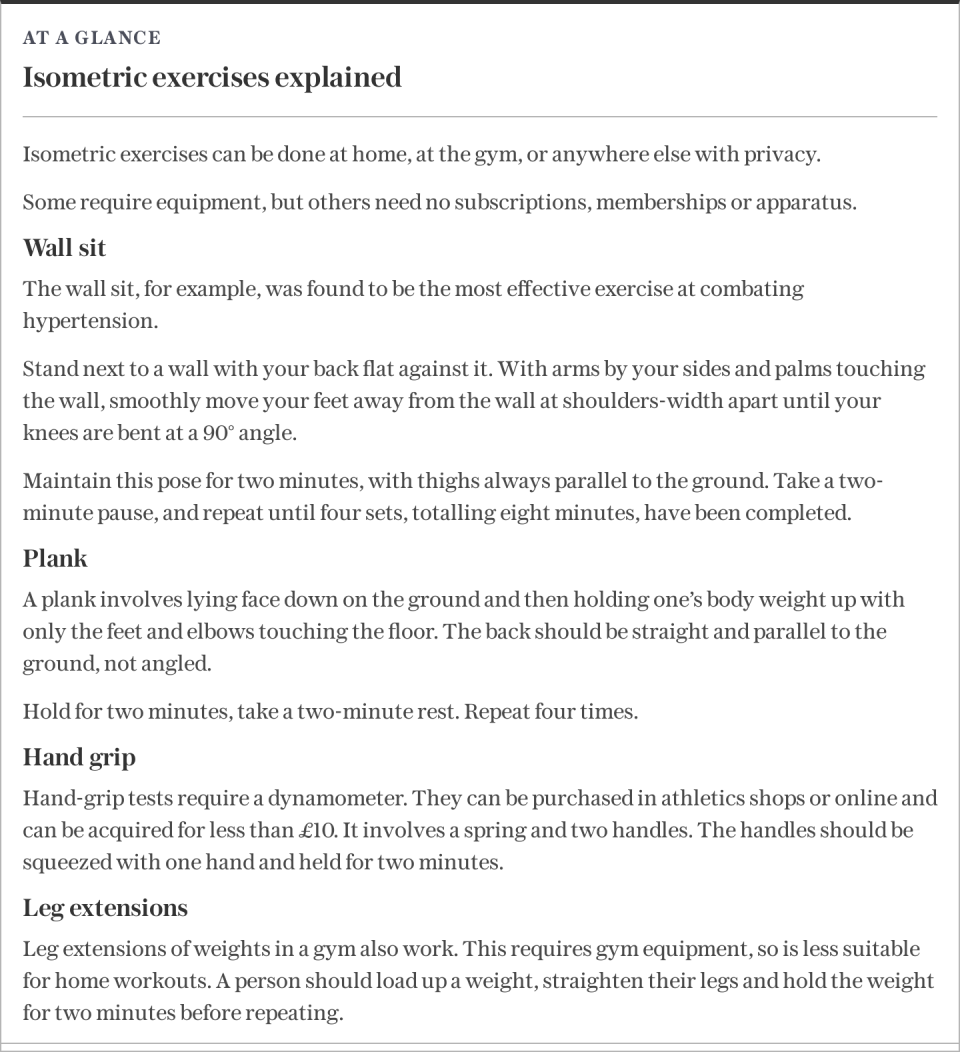The simple home workouts 'better for your blood pressure than jogging'

Going for a run, walk or bike ride has long been touted by doctors as the best way to lower blood pressure.
But now a study has found other activities and workouts which can be done at home are in fact better at preventing the condition.
So-called isometric exercises, which involve holding certain positions of mild difficulty for a couple of minutes at a time, have been found to reduce blood pressure by 80 per cent more than aerobic exercise.
Examples of such exercises include the plank, a wall sit, straightened legs with weights and holding a closed fist against a spring (see box below).
Scientists at Canterbury Christ Church University in the UK reviewed more than 200 trials which looked at a range of exercises and how they impacted blood pressure.
Aerobic exercise, which prevailing wisdom and the NHS say is the best for preventing hypertension, was found to reduce blood pressure by 4.49/2.53 mmHg, on average.
However, isometric training was found to lower systolic pressure – when the heart is contracted – by 8.24 mmHG (83 per cent more than cardio) and diastolic – in between pumps – by four units (58 per cent better).
Data from more than 15,000 people gathered from different studies conducted between 1990 and 2023 found that lifting weights and high intensity workouts, known as HIIT, reduced blood pressure by a similar amount to cardio.
The wall sit
The single most effective exercise a person could do was a wall sit, data shows.
Dr Jamie O’Driscoll, lead author of the study, told The Telegraph that “performing 4 two-minute wall sits [with two minutes rest in between] three times per week is an effective way to reduce your blood pressure”.
“Isometric exercise can be performed in your own home in the form of a wall squat, or handgrip,” he added.
The handgrip test, which involves squeezing a dynamometer that can cost less than £10, is designed to be held for a couple of minutes at a time at 3/10 exertion.

The blood pressure benefits of the handgrip exercise were first discovered around 50 years ago when fighter pilots kept passing out due to large G forces in F-16 jets. Squeezing the controls in the cockpit kept them awake by increasing blood pressure temporarily. Follow-up studies found these people had long-term benefits in the form of lower blood pressure.
People doing the wall sit, Dr O’Driscoll says, should do it four times and each time it should get harder, starting around a 3/10 difficulty before reaching a 9/10 for the final two-minute burst.
“These findings are promising, especially for members of the population who may find it difficult to perform regular dynamic exercise as it can be performed easily in the home environment,” he added.
“The results of this work demonstrate the value of performing static exercise for managing blood pressure; however, it is important to consider isometric exercise as complementary to pre-existing exercise modes, providing participants with a range of exercise choices rather than limiting them.”
Older data
The academics said that current exercise recommendations for the prevention and treatment of high blood pressure are based on “older data” and suggest that it may be time to review the current guidelines.
“Overall, isometric exercise training is the most effective mode in reducing both systolic and diastolic blood pressure,” according to the study.
“These findings provide a comprehensive data driven framework to support the development of new exercise guideline recommendations for the prevention and treatment of arterial hypertension.”
For the average adult high blood pressure is considered to be from 140/90mmHg.
When a person’s blood pressure is too high it puts extra strain on blood vessels, heart and other organs, such as the brain, kidneys and eyes.
Persistent high blood pressure can lead to a number of serious health problems including heart attacks, strokes and vascular dementia.
While there are medications which can help, people can make a number of life-style changes to help bring their blood pressure down including regular exercise, losing weight, cutting back on caffeine, alcohol and salt.
The study is published in the British Journal of Sports Medicine.

 Yahoo News
Yahoo News 
